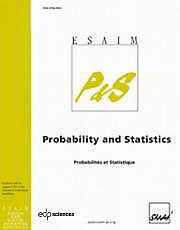Article contents
Random coefficients bifurcating autoregressive processes
Published online by Cambridge University Press: 03 October 2014
Abstract
This paper presents a new model of asymmetric bifurcating autoregressive process with random coefficients. We couple this model with a Galton−Watson tree to take into account possibly missing observations. We propose least-squares estimators for the various parameters of the model and prove their consistency, with a convergence rate, and asymptotic normality. We use both the bifurcating Markov chain and martingale approaches and derive new results in both these frameworks.
Keywords
- Type
- Research Article
- Information
- Copyright
- © EDP Sciences, SMAI 2014
References
- 7
- Cited by


